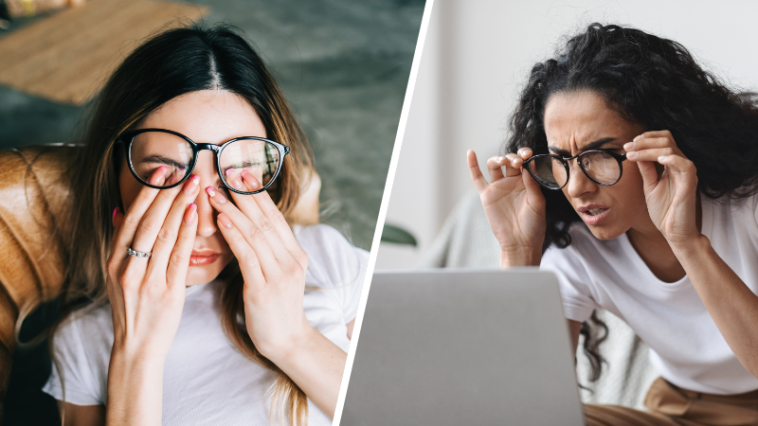Farsightedness is a common vision disorder that affects many people. Unlike myopia where distant objects appear blurry, it makes near vision difficult. Far vision will also be clearer. This problem occurs when the eyeball is too short or the cornea is too flat, preventing light from focusing properly on the retina, which often causes severe eye fatigue and headaches. Fortunately, there are several tips for living better with hyperopia. Discover practical advice to improve your visual comfort and preserve the health of your eyes on a daily basis.
Some tips to prevent eye fatigue
The Eye fatigue is a common concern among farsighted peopleespecially with prolonged use of screens. Take regular visual breaks is therefore crucial to avoid eye fatigue and maintain good visual health. To do this, follow the 20-20-20 rule: Every 20 minutes, look at something 20 feet away (about six meters) for at least 20 seconds. Additionally, take advantage of breaks to stand up and stretch, which improves blood circulation and reduces the risk of muscle strain. Integrate these frequent breaks into your daily routine, especially if you work in front of a screen for a long time. Also make sure that your workstation is well lit while avoiding excessive light contrasts. Also use Blue light filters on your screens to reduce fatigue and headaches.
Note further that dry eyes can make symptoms worse hyperopia. So use lubricating eye drops to maintain adequate hydration, especially if you spend a lot of time in dry or air-conditioned environments. Your oculist will surely be able to advise you on a suitable eye gel or thicker artificial tears if necessary. And of course, in addition, blink regularly to distribute tears evenly across the surface of the eye. Finally, avoid direct air currents on your face, such as those coming from fans or air conditioners.

A choice of suitable glasses and other correction options
For hyperopia people, choosing the right glasses is essential. At your optician, opt for convex glasses which correct near vision. Make sure the frame is comfortable and fits well, especially if you wear them all day. Anti-reflective lenses can also reduce glare, while photochromic lenses adapt to changes in light. In addition to the glasses, it is possible to consider specific contact lenses to hyperopia for greater convenience, especially for sporting activities. For those seeking a permanent solution, refractive surgery, such as LASIK, may be a viable option, although this requires a thorough evaluation by a vision health professional.
Suitable lighting in case of hyperopia
Lighting plays a crucial role for farsighted people, especially during up-close activities such as reading or working on a computer. To improve your daily visual comfort, make sure that the lighting in your home is sufficient and well distributed without being dazzling nor present marked shadow areas or excessive contrasts which could increase the strain on your eyes. Additionally, use reading lights for activities that require close attention. THE adjustable desk lamps with warm white LED light can notably reduce eye fatigue. Above all, place these light sources so as to avoid reflections on screens or shiny surfaces. Also consider using curtains or blinds to control natural light and again reduce reflections.
Finally, also adjust the brightness of your screens so that they are not neither too bright nor too dark et avoid looking at them in complete darkness.

Ergonomics of the workstation: to take care of in case of hyperopia
Good ergonomics can Significantly reduce eye fatigue and discomfort linked to hyperopia. Make sure your computer screen is at a distance of approximately 50 to 70 cm from your gaze et slightly below eye level. Also use an ergonomic chair to maintain correct posture with feet flat on the floor and arms at a right angle to the desk. Also adjust the height of your chair and desk to avoid leaning your head forward. Finally, consider using a document stand to minimize head movement between the document and the screen.
Relaxation exercises for the eyes, always useful in cases of hyperopia
Incorporating relaxation exercises for the eyes into your daily routine can help reduce eye fatigue and strain. For example, try palming: rub your hands together to warm them up, then gently place them over your closed eyes for a few minutes to relax them. Alternatively, make circular eye movements or follow moving objects to improve muscle flexibility. Another effective exercise is to alternately stare at a close object and a distant object for a few minutes. These exercises will strengthen your eye muscles and can thus improve your ability to focus and your visual comfort. Finally, you can also make eye movements from left to right and up and down to relax the eye muscles.
If you experience persistent symptoms of eye strain or blurred vision, consult an ophthalmologist for a thorough examination and personalized recommendations that will help you manage farsightedness effectively, adjust your prescriptions, and detect other eye problems (glaucoma, presbyopia) early. , age-related macular degeneration [DMLA]cataract, etc.).


